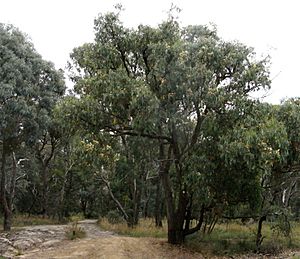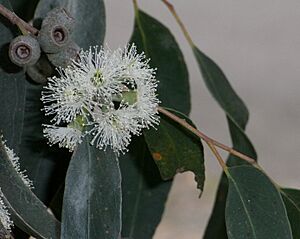Messmate stringybark facts for kids
Quick facts for kids Messmate stringybark |
|
|---|---|
 |
|
| Eucalyptus obliqua in the Macedon Ranges, Victoria | |
| Scientific classification | |
| Genus: |
Eucalyptus
|
| Species: |
obliqua
|
| Synonyms | |
|
|
The Eucalyptus obliqua, often called messmate stringybark or just messmate, is a type of tree. People also know it as brown top, brown top stringbark, stringybark, or Tasmanian oak. This tree is special because it only grows naturally in south-eastern Australia.
It has rough, stringy bark on its main trunk and bigger branches. The thinner branches have smooth, greyish bark. Its adult leaves are shaped like a spear or are slightly curved. The tree produces white flowers, and its flower buds grow in groups of seven to fifteen or more. After flowering, it forms cup-shaped or barrel-shaped fruits.
Contents
What Does Messmate Stringybark Look Like?
Eucalyptus obliqua is a tall tree. It can grow up to 90 m (300 ft) (about 295 feet) high. Sometimes, it grows as a smaller, bushy plant called a mallee. This tree also has a special woody swelling at its base called a lignotuber. This helps it regrow after fires.
The trunk can be as wide as 3 m (9.8 ft) (about 10 feet). It has thick, rough, stringy bark. Branches thicker than 80 mm (3.1 in) (about 3 inches) also have this stringy bark. But thinner branches have smooth, greenish or greyish bark.
Young plants have shiny green leaves. These leaves are broadly egg-shaped to spear-shaped. They are about 60–210 mm (2.4–8.3 in) long and 23–85 mm (0.91–3.35 in) wide. Adult leaves are shiny green on both sides. They are spear-shaped or curved, measuring 60–220 mm (2.4–8.7 in) long and 15–70 mm (0.59–2.76 in) wide. These leaves grow on a stalk called a petiole, which is 7–34 mm (0.28–1.34 in) long.
The flower buds grow in the leaf axils. They appear in groups of seven to fifteen or more. Each group grows on a stalk called a peduncle, which is 4–25 mm (0.16–0.98 in) long. The individual buds have smaller stalks called pedicels, 3–8 mm (0.12–0.31 in) long.
Mature buds are oval or club-shaped. They are 4–9 mm (0.16–0.35 in) long and 3–5 mm (0.12–0.20 in) wide. They have a cone-shaped or rounded cap called an operculum. This tree can flower in most months of the year, and its flowers are white.
The fruit is a woody, cup-shaped or barrel-shaped capsule. It is 6–12 mm (0.24–0.47 in) long and 5–11 mm (0.20–0.43 in) wide. The tallest known messmate stringybark in Tasmania is 86 m (282 ft) tall. Some trees have been recorded as tall as 98.8 m (324 ft).
How Messmate Stringybark Got Its Name
The Eucalyptus obliqua was first collected in 1777. This happened during Captain Cook's third trip. David Nelson and William Anderson found the specimens. They collected them at Adventure Bay on Bruny Island in what is now Tasmania.
The specimens were sent to the British Museum in London. There, Charles Louis L'Héritier de Brutelle studied them. L'Héritier realized these specimens belonged to a new group of plants. He named this new group Eucalyptus. He then gave the name Eucalyptus obliqua to this specific tree.
L'Héritier officially described the species in 1789. This description was in his book Sertum Anglicum. The name obliqua comes from a Latin word, obliquus. This means "oblique" or "unequal." It refers to the fact that the two sides of the leaf base are often not the same length.
Where Messmate Stringybark Grows
E. obliqua is found in the cooler parts of south-eastern Australia. You can see it from Kangaroo Island in South Australia. It grows across southeast South Australia, all over Victoria, and throughout Tasmania. In New South Wales, it mainly grows east of the tablelands. A few groups of these trees even reach southern Queensland.
This means it grows across a wide range of latitudes, from 28 to 43½ degrees South. It can be found from sea level up to 1,475 m (4,839 ft) (about 4,840 feet) high. This includes the Northern Tablelands of New South Wales.
The areas where it grows are humid or somewhat humid. Temperatures range from cool to warm. The amount of rain each year is between 500 and 2400 millimeters. It often gets very cold in winter, with severe frosts. However, very bad droughts are extremely rare.
This tree grows in many different types of soil. It prefers hilly or mountainous areas. In cool, mountainous regions, it forms tall open-forests. It grows alongside other Eucalyptus trees. These include E. fastigata (brown barrel), E. nitens (shining gum), E. cypellocarpa (mountain grey gum), E. viminalis (manna gum), and E. delegatensis (alpine ash).
Uses of Messmate Stringybark Wood
E. obliqua is one of Australia's most important hardwoods. Its wood is often sold together with E. regnans (Mountain Ash). They are sold as "Vic Ash" or "Tasmanian oak."
Messmate stringybark wood is a bit denser than E. regnans. Its density is usually between 720 kg/m3 and 830 kg/m3. It is also harder. The outer part of the wood, called sapwood, is pale brown. The inner part, called heartwood, is light brown.
The wood has a smooth texture. Its grain is usually straight, but sometimes it's interlocked. You can also see clear growth rings. It's common to find gum veins in the wood.
This timber has good hardness and strength. However, it doesn't last very long outdoors without treatment. It is easy to split, work with, glue, and stain. It's also good for steam bending.
Messmate stringybark wood is mostly used to make pulp for paper. It's also very popular for building and manufacturing. You'll find it used a lot in house building, for things like doors and windows (joinery), flooring, and furniture.
Gallery
-
Eucalyptus obliqua in Hospers Grove Maui)
-
Bark on E. obliqua near Blackburn Lake, Box Hill, Melbourne
-
Cultivated specimen in Wellington Botanic Garden, New Zealand
Images for kids
-
Tall trees in Galicia, northwest Spain
See also
 In Spanish: Roble australiano para niños
In Spanish: Roble australiano para niños






